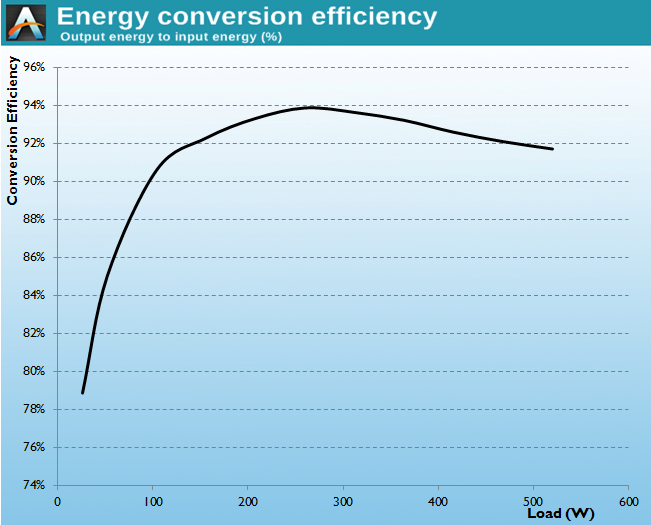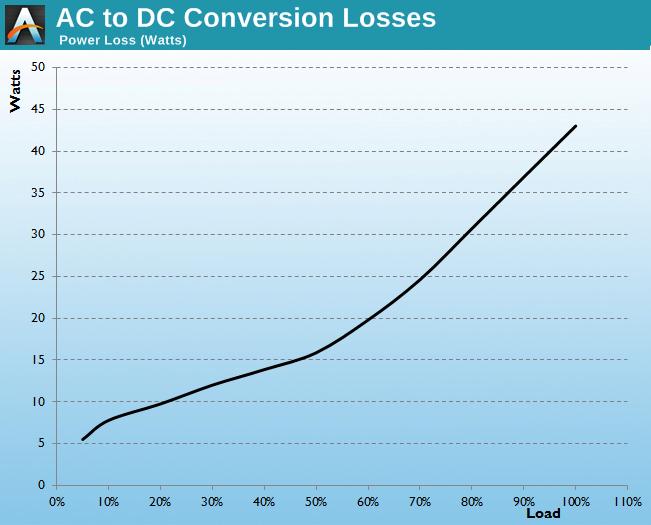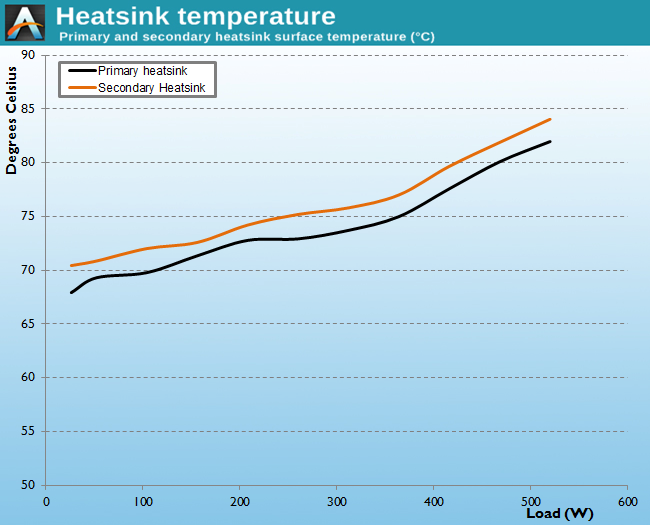SilverStone NightJar NJ520 Power Supply Review
by E. Fylladitakis on July 8, 2014 6:00 AM EST- Posted in
- Cases/Cooling/PSUs
- Seasonic
- PSUs
- Fanless
- SilverStone
Hot Test Results
From the tables below, it can be seen that the output power quality of the Silverstone Nightjar NJ520 is exceptional. The maximum voltage ripple that our instrumentation recorded was 34 mV under maximum load. Even with the unit heavily cross-loaded, the ripple on the 12V line only went up to 46 mV, which is much lower than the 120 mV design limit. Voltage regulation is less than 1% for the 12V line and just over 1.2% for the minor lines, performance figures that are excellent and comparable only to those of top-tier products.
| Main Output | ||||||||
| 104,72 W | 261,07 W | 389,82 W | 518,27 W | |||||
| 20,14% | 50,21% | 74,97% | 99,67% | |||||
| Line | Amperes | Volts | Amperes | Volts | Amperes | Volts | Amperes | Volts |
| 3.3 V | 3.05 | 3.34 | 7.62 | 3.33 | 11.44 | 3.32 | 15.25 | 3.30 |
| 5 V | 3.05 | 5.05 | 7.62 | 5.04 | 11.44 | 4.99 | 15.25 | 4.98 |
| 12 V | 6.56 | 12.07 | 16.39 | 12.03 | 24.59 | 11.99 | 32.79 | 11.96 |
| Line | Regulation (20% to 100% load) | Voltage Ripple (mV) | |||||
| 20% Load | 50% Load | 75% Load | 100% Load | CL1 12 V | CL2 3.3 V + 5 V | ||
| 3.3 V | 1.20% | 6 | 8 | 8 | 10 | 8 | 16 |
| 5 V | 1.45% | 10 | 12 | 16 | 16 | 10 | 18 |
| 12 V | 0.92% | 14 | 18 | 26 | 34 | 46 | 16 |
Although this unit is rated for operation with an ambient temperature of up to 40 °C, it performed just fine even with an ambient temperature of 50 °C. The energy conversion efficiency is reduced by about 0.4%, a fantastic result for increasing ambient temperature by 25 °C.
As the Nightjar NJ520 has no fan, the increase in ambient temperature essentially increases the operating temperature of the unit almost proportionally. The temperature of the primary and secondary side heatsinks is now reaching up to 81.9 °C and 84.1 °C respectively, figures that would make us feel uncomfortable but are not high enough to trigger a thermal shutdown by the protective circuit of the unit. The Nightjar NJ520 will simply shut down if overheated, as it has no active cooling and thus it cannot take any action to change its thermal performance. Obviously it's not really intended to be run in such extreme conditions, so plan accordingly.













44 Comments
View All Comments
hybrid2d4x4 - Thursday, July 10, 2014 - link
Agree. I got a Seasonic 400 Platinum Fanless model to run an upper-midrange gaming rig/HTPC, and it never gets more stressed than 60% of its rated power (measured at the wall, not internally). Short of some picoPSU units with minimal power regulation, there isn't anything out there that's a good match for a 'typical' integrated video system and there should be!Cygni - Tuesday, July 8, 2014 - link
The more fanless/silent part reviews, the better. Maybe I'm just old now, but I refuse to have a big leaf blower of a computer in every room anymore, even for my gaming computer. It's 2014!Really interested in this part. Think it will go well with my new low heat gaming build. More silent/quiet reviews please!
Spoogie - Tuesday, July 8, 2014 - link
Not really sure I'd buy this over the Kingwin. I have the 1k version of the Kingwin and it's truly silent with no elec noise at all and a 5 year warranty.http://www.silentpcreview.com/Kingwin_Lazer_Platin...
johnny_boy - Tuesday, July 8, 2014 - link
Why don't they build "dual PSUs" that combines a low wattage psu (max 10W) with a higher wattage psu such that it switches to the low one when the computer is in standby and switches back to the higher wattage one when powered up. A standard desktop PSU must be massively ineffecient when powering a computer on standby.DanNeely - Tuesday, July 8, 2014 - link
I think VStandby is on a separate circuit; JonhyGuru does test it. Looking a pair of recent reviews, one that was slammed as the worst they'd seen in a long time was only ~70% efficient; but that's still only a few watts of wastage even at max load. And while I've never measured it, I'd expect standby power to be at the low end of the draw range except when you hit the power button and trigger the first part of the resume sequence or if you have and are using USB charging from an otherwise offline system.E.Fyll - Wednesday, July 9, 2014 - link
Because that would either increase the cost of the unit dramatically or result to a less efficient configuration. Besides, the difference between the least efficient and the most efficient PSU at standby is just a few cents per annum from an economic point of view. Improving the efficiency of the PSU at such low a load has zero actual purpose, therefore the companies are sticking to meeting the base guidelines rather than wasting resources and increasing the cost of their products to do that.lucyfek - Tuesday, July 8, 2014 - link
Does the fanless PSU really matter (besides for the pricetag)?Once you realize that decent PSU with 120mm slow fan is barely audible (definitely quieter than average CPU or GPU). Besides that you'll need to evacuate the heat out of the case somehow.
I did have 2 fanless PSU back in the day. Was my PC really quiet because of that - nope.
mapesdhs - Wednesday, July 9, 2014 - link
See my earlier post for a longer suitable reply, but basically, supposedly quiet PSUs
are usually not at all quiet, hybrid PSUs are poor quality, and heat rises. The PSU
I bought had a big label & notice inside making it very clear how it should be used
to ensure proper natural convective airflow.
Ian.
viharm - Wednesday, September 4, 2019 - link
Completely agree with @mapesdhs. I am following a similar path to my custom home NAS build.viharm - Wednesday, September 4, 2019 - link
It matters very much when you start taking other noisy parts out of the system. I am going fanless, so the PSU fan becomes the loudest part :-)